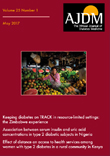Understanding Type 2 Diabetes: Causes, Symptoms, and Management
*Corresponding Author:
Received: 31-Jan-2024, Manuscript No. ajdm-24-129826; Editor assigned: 02-Feb-2024, Pre QC No. ajdm-24-129826 (PQ); Reviewed: 16-Feb-2024, QC No. ajdm-24-129826; Revised: 21-Feb-2024, Manuscript No. ajdm-24-129826 (R) ; Published: 28-Feb-2024, DOI: 10.54931/AJDM-32.1.6.
Description
Type 2 diabetes, a chronic metabolic disorder characterized by high blood sugar levels, is a significant global health concern. This condition affects millions of individuals worldwide, with its prevalence steadily rising. Understanding the causes, symptoms, and management strategies for type 2 diabetes is crucial for both prevention and effective treatment. Type 2 diabetes develops when the body becomes resistant to insulin or fails to produce enough insulin to regulate blood sugar levels effectively. While genetics play a role in predisposing individuals to this condition, lifestyle factors such as poor diet, lack of physical activity, and obesity significantly contribute to its development. Other risk factors include age, ethnicity, family history, and certain medical conditions like metabolic syndrome. The symptoms of type 2 diabetes can vary from person to person and may develop gradually, making them easy to overlook. Common signs include frequent urination, increased thirst, unexplained weight loss, fatigue, blurred vision, slow wound healing, and recurrent infections. If left untreated, type 2 diabetes can lead to severe complications such as cardiovascular disease, nerve damage, kidney failure, and vision problems. Managing type 2 diabetes involves a multifaceted approach aimed at controlling blood sugar levels, preventing complications, and improving overall health. Lifestyle modifications, including adopting a balanced diet and engaging in regular exercise, are fundamental pillars of diabetes management. A diet rich in fiber, whole grains, fruits, vegetables, lean proteins, and healthy fats can help stabilize blood sugar levels and promote weight loss. Physical activity plays a crucial role in managing type 2 diabetes by improving insulin sensitivity and aiding in weight management. Aim for at least 150 minutes of moderate- intensity aerobic exercise per week, along with strength training exercises at least two days a week. In addition to lifestyle changes, medication may be necessary to control blood sugar levels effectively. Oral medications such as metformin, sulfonylureas, and thiazolidinediones help improve insulin sensitivity or stimulate insulin production. In some cases, insulin therapy may be required to supplement natural insulin production. Regular monitoring of blood sugar levels is essential for individuals with type 2 diabetes to assess treatment effectiveness and adjust medication or lifestyle interventions accordingly. Home blood glucose monitoring devices allow individuals to track their blood sugar levels conveniently and make informed decisions about their diabetes management. While certain risk factors for type 2 diabetes cannot be modified, such as genetics and age, adopting a healthy lifestyle can significantly reduce the risk of developing this condition. Maintaining a healthy weight through proper diet and exercise is one of the most effective preventive measures. Limiting the intake of sugary and processed foods, quitting smoking, moderating alcohol consumption, and managing stress levels also contribute to diabetes prevention. Regular medical check-ups, including screenings for blood sugar levels and other risk factors, are essential for early detection and intervention. Educating individuals about the importance of preventive measures and empowering them to make healthy lifestyle choices are crucial components of diabetes prevention efforts. In conclusion, type 2 diabetes is a complex metabolic disorder that requires comprehensive management strategies encompassing lifestyle modifications, medication, and regular monitoring. By understanding the causes, symptoms, and preventive measures associated with type 2 diabetes, individuals can take proactive steps to mitigate their risk and achieve better health outcomes.
Acknowledgement
None.
Conflict Of Interest
The author has nothing to disclose and also state no conflict of interest in the submission of this manuscript.





